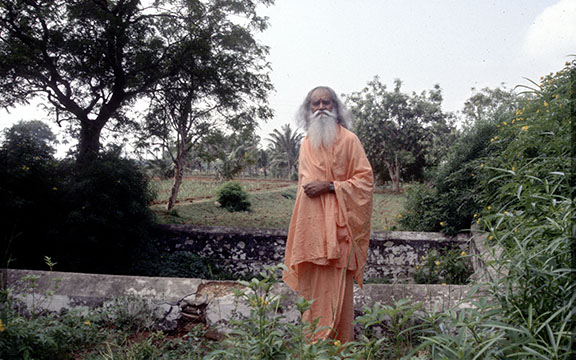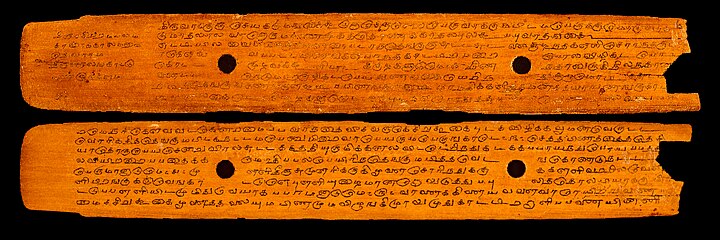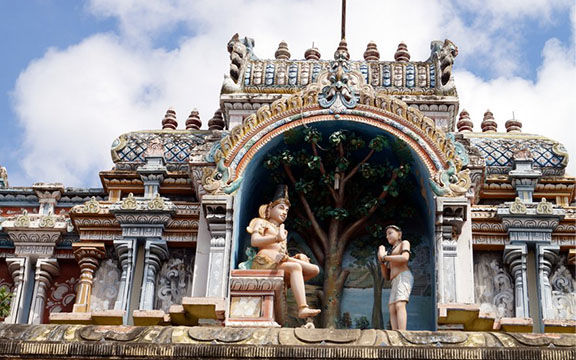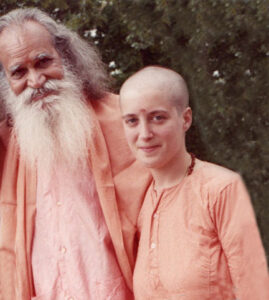
Photo: Swami Satchidananda standing by the well on the family farm, mid-1980s. Just behind was the hut where he stayed in seclusion.
In Part 7 of this series, Ramaswamy (Swami Satchidananda’s birth name) had expressed his deepening spiritual yearnings to his parents and they agreed to not pressure him into remarriage. Instead, they gave him time to devote himself to religious study and meditation while still living at home. However, as his spiritual practice deepened, Ramaswamy found the everyday noises and activities in his family home—people talking, floors being swept, doors being opened and closed—began to disturb him. He was becoming too finely sensitized to his inner life to remain in the house and requested that his parents allow him to live in the serenity of the family’s flower garden, one and a half miles away.
In this tranquil setting, a small hut was constructed—a modest, cave-like structure with clay walls and a tiled roof, nestled among fragrant blossoms. Here, Ramaswamy would rise before dawn, bathe in the cool waters of a stone well, and begin his day with Hatha Yoga, meditation, and study.
Ramaswamy immersed himself in the works of the Tamil bhakti saints, as well as teachings from Sri Ramakrishna Paramahamsa, Swami Vivekananda, and Swami Sivananda. These sages deeply influenced his spiritual life and his synthesis of Integral Yoga, which he would later bring to the Western world. We’ll begin this next chapter of Ramaswamy’s journey considering the further influences of Tamil Shaivism and its bhakti poet-saints.
The Continued Inspiration of a Divine Path of Devotion
In the heart of South India, where the sacred river Kaveri flows, lies a rich and profound spiritual tradition known as Tamil Shaivism. This path venerates Lord Shiva as the supreme deity, embodying both the transcendent and immanent aspects of existence. Emerging from the region of Tamil Nadu, Tamil Shaivism is a vibrant tapestry of devotion, philosophy, and mysticism, a tradition that has inspired countless seekers for centuries.
The rise of Tamil Shaivism in Southern India around the 6th century CE marked a profound spiritual awakening that coincided with the decline of Buddhism in the region. This emergence was not just a shift in religious orientation but the blossoming of a vibrant, devotional tradition that would transform the spiritual landscape of India. At its heart were the Nayanars, a group of saint-poets who dedicated their lives to Lord Shiva, composing hymns that were filled with love, longing, and the deepest devotion.

Photo: A palm-leaf folio of Tevaram manuscript copied in a Tamil Shiva temple about 1700 CE.
Three of these saints, Appar, Sambandar, and Sundarar, lived between the 6th and 8th centuries CE and contributed significantly to what would later become known as the Tevaram, a revered collection of hymns that forms part of the “Tamil Veda” of Shaivism. Alongside the Tiruvasagam by Manikkavasagar (also, Manikkavacakar) in the 9th century, these works became the spiritual bedrock of Tamil Shaivism, emphasizing an intense and personal relationship with Siva that transcended ritual and formalism.
A Devotional Revolution: The Heart of Tamil Saivism
Tamil Saivite hymns were revolutionary in their approach. They emphasized intense devotion (bhakti), a profound sense of humility and unworthiness before God, and the absolute importance of Divine Grace for spiritual progress. This was a stark contrast to the more ritualistic Brahmanical traditions of the time, which often focused on formal rites and elaborate ceremonies. Instead, Tamil Shaivism presented a direct, heartfelt path to the Divine, one that could be walked by anyone, regardless of caste or social status.
The rise of this devotional path was a beacon of hope, offering an alternative to the ascetic practices of Jainism and the intellectual traditions of Buddhism, which were prevalent in the region. Tamil Shaivism positioned itself as a tradition of passionate love for Shiva, the supreme deity, advocating a surrender that was not just of the mind but of the heart. It was a call to see Shiva in all things, to feel His presence in every aspect of life, and to surrender completely to His Divine Grace and Blessings.
A Tradition of Love and Grace
The teachings of the Nalvars (“The Four”) — Appar, Sambandar, Sundarar, and Manikkavasagar — became central to this evolving tradition. They sang of Shiva’s greatness, His compassion, and His endless love. Their hymns were not just songs; they were a profound dialogue with the Divine, a poetic expression of the soul’s deepest yearnings. Manikkavasagar’s Tiruvasagam, in particular, stands as a masterpiece of Tamil devotional literature, capturing the essence of surrender, longing, and divine love.
These saints shaped a tradition that went beyond mere philosophical inquiry. They also began more deeply transforming the inner life of Ramaswamy. These Tamil poet-saints called for an inward transformation, a path where passionate devotion to God and a recognition of Divine Grace were seen as the true means to spiritual liberation.
In their poetry, they portrayed a God who was not distant but deeply personal, a God who could be loved, questioned, and approached with the simplest of offerings—a sincere heart. Ramaswamy soon found his wounded heart bathed, renewed, and revived by these poems and hymns.
The Bhakti Poet-Saints Who Inspired Ramaswamy
While living in the flower garden, Ramaswamy found deep inspiration in the writings of saints like Pattinathar and Manikkavasagar. Pattinathar, who lived between the 10th and 13th centuries, is renowned for his hymns, which are marked by themes of renunciation, the impermanence of worldly life, and the quest for spiritual liberation. This would begin to have profound spiritual repercussions in the direction Ramaswamy’s life would soon take.
Ramaswamy was equally drawn to the devotional intensity of Manikkavasagar’s hymns. Manikkavasagar’s Tiruvasagam is revered for its profound mystical depth and emotional intensity, capturing the essence of surrender and love for Shiva. A famous verse reflects this spiritual depth:
“O Shiva! O Lord of the golden hall!
In the inner chamber of my mind, you dance.
In the outer world, you are my guiding light.
In everything, everywhere, O Lord, you are my all.”
These verses reveal the soul’s journey from ignorance to enlightenment, a journey characterized by surrender, grace, and divine love. His poetry is not just a devotional offering but a profound spiritual inquiry that blurs the lines between the self and the Divine.

Photo: Manikkavsagar depicted in front of Lord Shiva, Avudaiyar Koil.
Avudaiyar Koil, also known as Thiruperunthurai, is a Shiva temple situated near Pudukkottai in South India. It is said that here, Manikkavasagar was personally initiated by Lord Shiva. Due to the deep spiritual connection between Manikkavasagar and Lord Shiva, it was ordained that, in this temple, the image of Manikkavasagar would replace that of Lord Shiva during all festivals and processions. As a result, during processions, Manikkavasagar’s murti (sacred image) is carried on Nandi around the temple instead of the traditional image of Lord Shiva.
One of Manikkavasagar’s most cherished verses, which deeply resonated with Ramaswamy and remained a favorite he often quoted during his service in America as Swami Satchidananda, beautifully captures his own profound realization of Divine Grace:
“I gave myself to You,
And You gave Yourself to me.
Tell me, O Lord, who has lost in this bargain?
You, who are beyond all,
Or I, who have gained everything?”
The mystical and emotional intensity of Manikkavasagar’s verses, invited Ramaswamy, as they invite us, to feel, rather than just intellectually understand, the nature of divine love and spiritual aspiration. From the hymns of the Nayanars to the mystic poetry of Manikkavasagar, Tamil Shaivism continues to offer a timeless call to experience the Divine presence both within and around us.
For Ramaswamy, the teachings of Tamil Shaivism were not just ancient wisdom but a living reality that shaped his spiritual path. Through the influence of the bhakti poet-saints, he found the strength to pursue his own journey of renunciation, bhakti, and surrender. The verses of these saints reminded him—and remind us—that the Divine’s Grace is boundless, and the path to spiritual fulfillment lies in recognizing that Grace, surrendering to it, and allowing it to transform our hearts and lives as we journey toward spiritual awakening.
In our next installment, we’ll explore the other sages and saints that inspired Ramaswamy’s year-long immersion in their teachings.
About the Author:
 Swami Premananda, Ph.D. is a senior disciple of Sri Gurudev Swami Satchidananda and served as his personal and traveling assistant for 24 years. Her interest in the study of the spiritual roots of the Integral Yoga tradition and lineage was inspired over many years of traveling with Sri Gurudev to the various sacred sites throughout India that are a part of this tradition. She also undertook a 2-year immersion into the nondual Saiva Yoga Siddhar tradition that is at the heart of Sri Gurudev’s spiritual roots. She further studied the history, sacred texts, and teachings of Tamil Saivism including the Siddhars, bhakti poet saints, as well as the spiritual luminaries who lived in the 19th – 20th centuries and who inspired Sri Gurudev, such as Sri Ramana Maharshi, Swami Ramdas, and Swami Vivekananda. She serves as editor of Integral Yoga Magazine, Integral Yoga Publications; senior archivist for Integral Yoga Archives; and director of the Office of Sri Gurudev and His Legacy.
Swami Premananda, Ph.D. is a senior disciple of Sri Gurudev Swami Satchidananda and served as his personal and traveling assistant for 24 years. Her interest in the study of the spiritual roots of the Integral Yoga tradition and lineage was inspired over many years of traveling with Sri Gurudev to the various sacred sites throughout India that are a part of this tradition. She also undertook a 2-year immersion into the nondual Saiva Yoga Siddhar tradition that is at the heart of Sri Gurudev’s spiritual roots. She further studied the history, sacred texts, and teachings of Tamil Saivism including the Siddhars, bhakti poet saints, as well as the spiritual luminaries who lived in the 19th – 20th centuries and who inspired Sri Gurudev, such as Sri Ramana Maharshi, Swami Ramdas, and Swami Vivekananda. She serves as editor of Integral Yoga Magazine, Integral Yoga Publications; senior archivist for Integral Yoga Archives; and director of the Office of Sri Gurudev and His Legacy.

